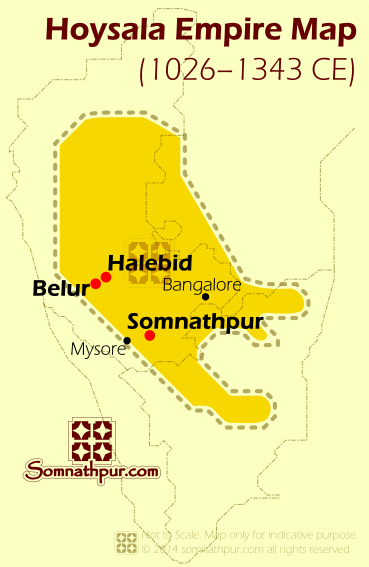Hoysala Empire

Among many other things, the most prominent artifact of Hoysala history is the unique architectural style they developed over the centuries, popularly called the Hoysala Architecture. Karnataka has very many monuments built during the Hoysala period.
Among many other things, the most prominent artifact of Hoysala history is the unique architectural style they developed over the centuries, popularly called the Hoysala Architecture. Karnataka has very many monuments built during the Hoysala period.
T
he Chennakeshava Temple in Somnathpur was built during the heydays of the Hoysalas, the dynasty that ruled most part of the present day Karnataka for over 400 years.The origin of Hoysalas are a bit sketchy, but easily dates back to about 1000 CE, and continued to be a significant power in the peninsular India till mid 13th century CE. Of this period, a span of the later 200 years is generally considered as the significant period of the Hoysalas.
The political future of the upcoming Hoysalas was greatly influenced by the two larger neighboring powers – the Chalukyas of Kalyani and the Cholas of Thanjavur.
During the 11th and 12th centuries power in the southern peninsula were focused on these two kingdoms. If you draw a diagonal line on the south India’s map connecting Vijayawada in Andhrapradesh to Mangalore in Karnataka, you can get a very approximate border between these two empires.
The lower portion of this line was under the power of the Cholas and the upper part of the peninsula was ruled by the Chalukyas.
There were a number of smaller kingdoms and territories along this frontier of the two powers. These were feudatories or vassal territories were ruled by the local kings or the chieftains. These buffer kingdoms were never fully independent, but acted as the subordinates of the larger powers. Hoysalas had their origin as one of these kingdoms.
Among many other things, the most prominent artifact of Hoysala history is the unique architectural style they developed over the centuries, popularly called the Hoysala Architecture. Karnataka has very many monuments built during the Hoysala period.
Though the temples at Belur and Halebid are more popular in the tourism circuit, the Chennakesava temple has unparalleled merits in terms of completeness and perfection.
The Somnathpur temple was built in 1268, a period which saw the perfection of this architectural style. Much of it is well preserved , almost to the original design.
The construction of the Kesava temple is attributed to a high ranking officer called Somnatha, under Narasimha III (1254–1291). So the place was named Somnathpur.
Mid 14th century saw Hoysala's decline. Eventually they faded into the then upcoming Vijayanagara , that later wield power across the peninsular India.
If Belur and Halebid famed as the capital of the Hoysala's, Hampi became the spectacular capital of the Vijayanagara kings.
All are very popular flagship tourism attractions in Karnataka.
Hoysala Kings:
- Nripa Kama II (1026–1047)
- Hoysala Vinayaditya (1047–1098)
- Ereyanga (1098–1102)
- Veera Ballala I (1102–1108)
- Vishnuvardhana (1108–1152)
- Narasimha I (1152–1173)
- Veera Ballala II (1173–1220)
- Vira Narasimha II (1220–1235)
- Vira Someshwara (1235–1254)
- Narasimha III (1254–1291)
- Veera Ballala III (1292–1343)

Hoysala Empire during 12th Century CE. Belur was the original capital, later moved to Halebid.
The political future of the upcoming Hoysalas was greatly influenced by the two larger neighboring powers – the Chalukyas of Kalyani and the Cholas of Thanjavur.
During the 11th and 12th centuries power in the southern peninsula were focused on these two kingdoms. If you draw a diagonal line on the south India’s map connecting Vijayawada in Andhrapradesh to Mangalore in Karnataka, you can get a very approximate border between these two empires.
